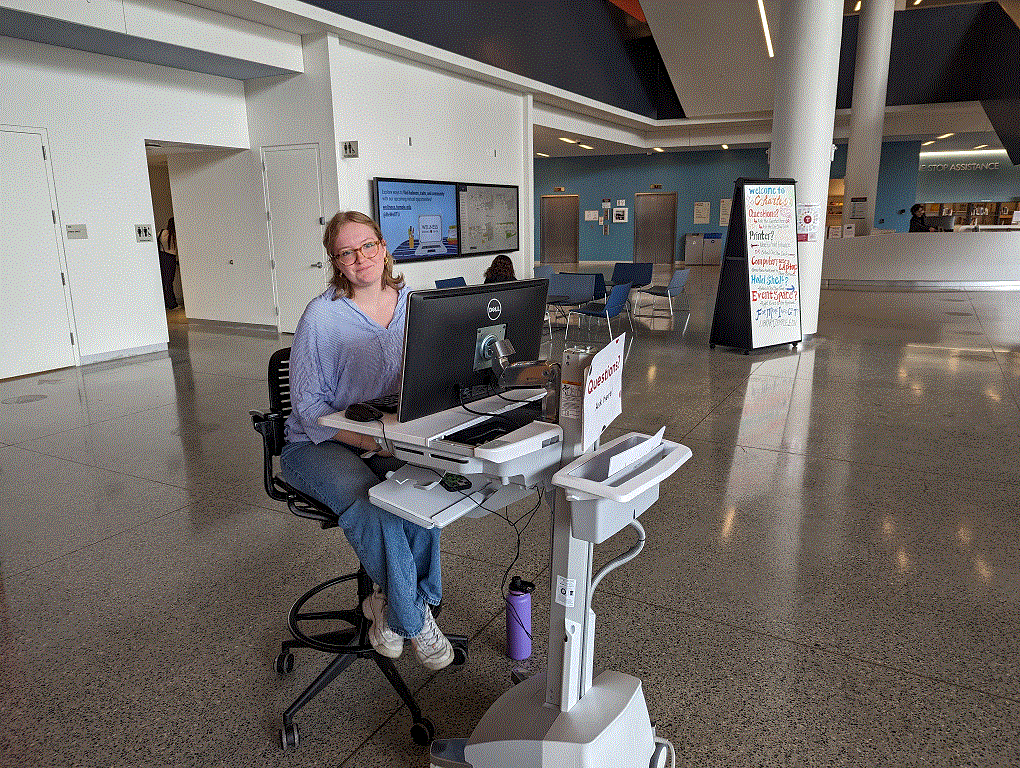Walking into the vast atrium space of Charles Library is awe-inspiring. It can also be overwhelming, particularly to new students when the semester first starts. While we have many ways of counter-acting that feeling – helpful security guards, Emily Schiller’s friendly and creative whiteboards, Access Services also instituted a greeter program in October 2022.

Access Services’ Alex Rosen supervises the students who work at the One Stop Assistance Desk (OSAD) and now, the kiosk, providing two complimentary service points on the first floor.
Working with Jackie Sipes, they developed an assessment plan using both metrics and qualitative data to understand and improve the greeter service. They carefully analyzed transaction counts, question types, and traffic patterns to optimize the use of students at the two service locations. In addition, students regularly provide reflections on their experience through an online form designed by Jackie.
I spoke with Alex last week about the project, what they’re learning and the new kinds of questions the assessment process generates.
Nancy: Tell me more about how you decide to deploy students where?
Alex: As part of their regular shifts at the desk, student workers are deployed at the kiosk. Originally, we hired someone expressly for the kiosk, but out of necessity, each student is now assigned one hour a week. There is the option to pick up more. Mostly we’re basing this off the data tracker (transactions) number, averages, considering the traffic and balancing with interactions at the OSAD, which can be very busy. So we try to make sure the kiosk is staffed when we expect it to be busy elsewhere.
We are also learning about how important it is to place the kiosk where it is visible, especially because students don’t always see the OSAD. The kiosk gets the most visibility when it’s outside the Events Space, but that can interfere with traffic to the space itself, or attendees think the kiosk is for information about the event. It’s uncomfortable when the kiosk is stuck inside a tour group of high school students. What works best is pairing the white board with the kiosk.
One advantage of the portability of the kiosk is we can try different locations, and also be adaptable to other things happening in the atrium. Combined, time and placement influence the traffic the most.
Nancy: Do the students get special training? Is this something they opt into or is it part of the regular duties of the OSAD student?
Alex: Each student is scheduled to work at the kiosk one hour each week, but some prefer working at the main desk, where they feel less “exposed”. The kiosk has been useful in helping students to navigate the atrium area’s services. Interaction statistics indicate that the majority (61%) of questions are directional, but students also handle a good number of basic reference questions.

The students’ reflections provide additional insight into what is going on at the desk:
“I noticed a lot of people who seem to be hesitant to ask for help at the OSAD desk are a lot more willing to ask for help at the greeter kiosk. I assume because the experience is more intimate for them without a desk and plexiglass in between us. That is probably the most rewarding part of the greeter kiosk, as it is easier to help and connect with people who are more shy/timid”
“what is hard is hearing how busy OSAD is and not being able to help”
Alex: The irony too is that currently, students working at the kiosk are limited in the kind of information they are supposed to provide – so that can be frustrating to them. But the potential for side-by-side review of the computer screen makes some kinds of information sharing easier. Students assume that everyone does the same thing and can be frustrated with the response to their question of, “I’m not a librarian, let me give you three handouts.”
Nancy: The challenge for you is to figure out how best to balance the types of services available at each of the service points – in a way that is natural to the space and the traffic flow as well as the kind of information needs that you’re seeing. So we avoid bouncing students from one desk to another!
It sounds as though you are learning a lot. The assessment process is providing some useful insights into scheduling needs, but your analysis informs our understanding of the different types of interactions supported by different physical setups. Thanks for sharing your experience with us.
